Mark Sisson's Blog, page 116
February 4, 2019
Even a Perfect Diet Will Fail Without Stress Management
It’s Monday, everyone! And that means another Primal Blueprint Real Life Story from a Mark’s Daily Apple reader. If you have your own success story and would like to share it with me and the Mark’s Daily Apple community please contact me here. I’ll continue to publish these each Monday as long as they keep coming in. Thank you for reading!
 On November of 2017 I sent a story to Mark’s Daily Apple. A brief story of my life at the time and how I got there. I’ve re-read that letter a couple of times and I’ve thought maybe I should have waited or I should have said more, so I thought maybe an update from then to now would be helpful.
On November of 2017 I sent a story to Mark’s Daily Apple. A brief story of my life at the time and how I got there. I’ve re-read that letter a couple of times and I’ve thought maybe I should have waited or I should have said more, so I thought maybe an update from then to now would be helpful.
My primal story started as a diet and exercise program, I needed to get back into shape so I hit the gym, or in my case hit the treadmill in my garage, and went on a diet. I did what everyone else does when they want to lose weight and “get healthy.” If you read my original story and look at the pictures, I figured it out. I lost 60 pounds total and improved my numbers to a point my doctor was amazed at my results. I completed the Primal Health Coach course, and Mom loved to hear about what I was learning.

Everything was great, well almost everything. My mom’s health was declining fast, she was slowly losing her battle with cancer. My sisters and I started staying weekends with her to spend as much time as possible with her, we would drink wine, and talk about the past and laugh about all the crazy things we did. My brother-in-law would come down about once a month and bring steaks, and we would grill over a grate in the fireplace and drink beer and wine and laugh. Mom couldn’t really eat that much anymore, but we had a lot of fun.
I started going to visit every day after work, and I’d grab a bag of chips and a case of beer to have when I got there, a candy bar or two for the way there. Eventually mom needed 24-hour care so she moved in with my sister in Michigan, but I still went every day to take care of the house. In April my mom lost her battle with cancer. My sisters and I would get together as much as we could to get the house ready to sell, and finalize the estate. I was there everyday—as the executor I felt I had to keep things moving and get everything done. I would buy beer and snacks and a bottle of whisky for when I was there….
I thought it was important to share that story because it’s real. During that time I gained 10 pounds, my cholesterol was high again and my sugar was elevated. Luckily for me I know how to correct all those issues and have. I failed where everyone on a diet fails—when the diet stops. The part I missed was the rest of life. Diet is important but even a perfect diet will fail without stress management. My stress management was alcohol, my comfort zone, and we all know your body burns alcohol first. I got off track and used my life problems as an excuse. Sometimes even a coach needs some coaching. This has kind of been a failure story instead of a success story, but I’m still writing.
I’ve taken what I learned from the Primal Health Coach Institute, and have started to develop my own brand, “Primal Hippie.” I started a very easy to read blog “primalhippie.net.” I blog a lot about stress from daily life and ideas how to manage that stress. I’ve taken the laid back, have fun attitude and mixed it with some nutrition advice and tried to aim it towards the younger generation because it’s easier to prevent disease than to cure it.
It’s very obvious to me that the trend towards living a holistic healthy life is happening, the amount of available, affordable, organic foods is on the rise. The merging of major food giants with small health-minded companies is another great step—great work Mark. There is even some common ground being found with the paleo/vegan world. This trend is still very personal to me. Since my first post, four more friends of mine have been diagnosed with cancer, one is currently non-responsive. I hear a lot about all the advances in medicine, and yet here we are. It’s time to educate the young people, and make healthy foods the norm not the exception.
Thanks Mark for all your passion and effort and giving me the chance to share my story, Grok on!
Bradley Nickell

The readers featured in our success stories share their experiences in their own words. The Primal Blueprint and Keto Reset diets are not intended as medical intervention or diagnosis. Nor are they replacements for working with a qualified healthcare practitioner. It’s important to speak with your doctor before beginning any new dietary or lifestyle program, and please consult your physician before making any changes to medication or treatment protocols. Each individual’s results may vary.

The post Even a Perfect Diet Will Fail Without Stress Management appeared first on Mark's Daily Apple.



February 1, 2019
Weekly Link Love—Edition 14
 Research of the Week
Research of the WeekNeanderthals were likely sprinters, not joggers.
Low-carb diets, whether they be high-protein and/or high-fat, plant-based or animal-based, are not associated with elevated coronary artery calcium.
Fried chicken and fried fish consumption linked to increased cardiovascular and overall mortality.
8-hour feeding windows are totally safe in obese adults.
Recommending breakfast for weight loss in adults may have the opposite effect, according to a new meta-analysis.
Women are more likely to choose short-term and long-term partners with their dad’s eye color.
New Primal Blueprint Podcasts

Episode 307: Alexander Haskell: Host Elle Russ chats with Dr. Alexander Haskell about prescription drug addiction.

Episode 308: Keto Q&A with Brad Kearns: Host Brad Kearns answers listener questions about keto.
Each week, select Mark’s Daily Apple blog posts are prepared as Primal Blueprint Podcasts. Need to catch up on reading, but don’t have the time? Prefer to listen to articles while on the go? Check out the new blog post podcasts below, and subscribe to the Primal Blueprint Podcast here so you never miss an episode.
Media, Schmedia
Leading cardiovascular health journal publishes stern warning against “social media misinformation” regarding statins and cholesterol.
Holocaust survivors lived long lives.
Interesting Blog Posts
George Henderson reviews a new fasting-lite book.
How seed oils make sun bathing dangerous.
Social Notes
Went to the grand opening of Primal Santa Cruz, a new Primal/paleo restaurant.
Everything Else
Food education film from the 1950s.
Sonar may cause suicidal ideation in whales.
Single men and married men smell different.
How much rich, meaty aromatherapy do you deserve?
Music is essential for dementia patients.
The Golden Bolt has passed.
Things I’m Up to and Interested In
Podcast I enjoyed: Elle Russ appearing on Tom Bilyeu’s Health Theory podcast to discuss why you probably have a thyroid problem without knowing it.
They had me at “evolutionary”: An evolutionary perspective on why food overconsumption impairs cognition.
This is actually quite cool: Elephant seals took advantage of the government shutdown to take over a beach. They still won’t leave.
Great news: Hyperbaric oxygen treatment improves Alzheimer’s.
I wouldn’t mind doing inpatient here: The Alaska hospital that serves whale and caribou.
Question I’m Asking
Do you notice a connection between how much you eat and how well you think?
Recipe Corner
Hot and sour soup, a soup with an intriguing flavor profile.
Ramen in the Instant Pot.
Time Capsule
One year ago (Jan 27– Feb 2)
5 Suggestions for Becoming Less Civilized – How to inject a little wildness back in.
Primal Kitchen Efficiency: 13 Tips for Daily Organization and Smooth Cooking– Run a tight ship.
Comment of the Week
“I’m going to check my iron levels, and also, for some strange reason I’m starting to itch all over …”
– With any luck those are plague fleas and your iron levels will be perfect, HealthyHombre.

The post Weekly Link Love—Edition 14 appeared first on Mark's Daily Apple.



Primal Sloppy Joes
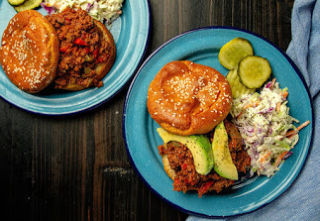 Nothing says comfort food quite like sloppy joes. The go-to of potlucks and family dinners for generations, they’ve got the tangy and hearty flavor even kids gravitate to. Many versions, including canned sauces, however, contain added sugars or even high fructose corn syrup—such a shame, since the basic ingredients of sloppy joes need no sweeteners when done right.
Nothing says comfort food quite like sloppy joes. The go-to of potlucks and family dinners for generations, they’ve got the tangy and hearty flavor even kids gravitate to. Many versions, including canned sauces, however, contain added sugars or even high fructose corn syrup—such a shame, since the basic ingredients of sloppy joes need no sweeteners when done right.
Bring this classic back to your healthy menu with this recipe for delicious sloppy joe meat sauce—and the grain-free buns to deliver that goodness. Enjoy!
Grain-Free Buns
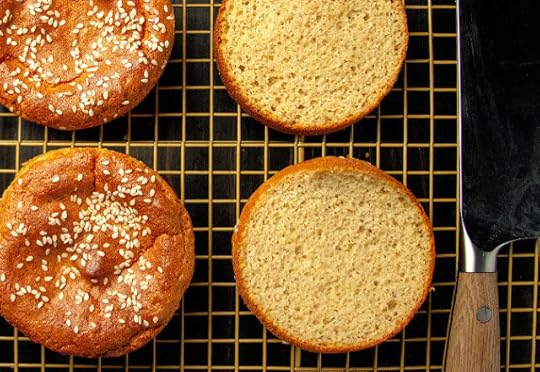
Servings: 4 Buns
Time in the Kitchen: 15 minutes, plus 15 minutes to bake
Ingredients:

1 ½ cups super-fine blanched almond flour (165 g)
½ teaspoon kosher salt (2.5 ml)
½ teaspoon baking soda (2.5 ml)
4 large eggs, separated
5 tablespoons Primal Kitchen® Avocado Oil (75 ml)
1 tablespoon honey (15 ml)
½ teaspoon apple cider vinegar (2.5 ml)
¼ teaspoon cream of tartar (1.25 ml)
Optional: Poppy seeds or sesame seeds to sprinkle on top
Tools: Silicone bun mold
Instructions
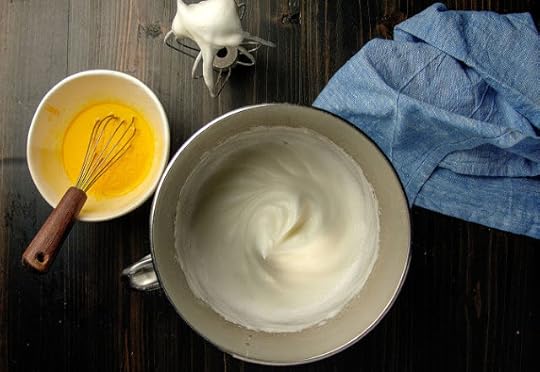
Preheat oven to 375 ºF/190 ºC.
In the bowl of a food processor, mix together the almond flour, salt and baking soda so that no clumps remain.
Add the egg yolks, avocado oil, honey and apple cider vinegar. Blend until thick and smooth.
In the bowl of an electric mixer, combine the egg whites and cream of tartar. Using the whisk attachment, whisk until the egg whites are fluffy and soft peaks form (when the whisk is lifted out of the egg whites, a soft peak should pull up).
Pour 1/3 of the egg whites into the food processor. Pulse until combined, scraping down the sides as needed. Add another 1/3 of the egg whites, and pulse again until combined into a wet batter.
Scrape the dough out of the food processor and into the bowl with the remaining egg whites. Use a spatula to gently fold the egg whites into the dough. Fold and mix until there are no white streaks, but be gentle; the air in the egg whites helps the dough rise into a loaf with a light texture.
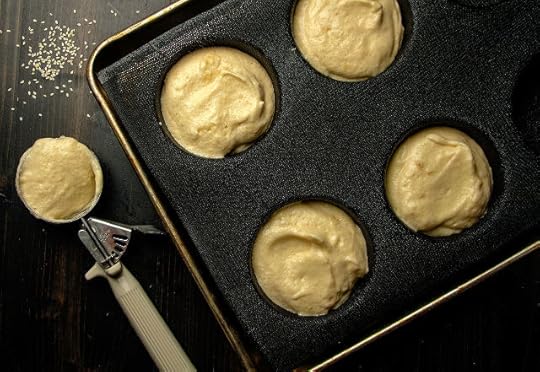
Place the bun pan on a baking sheet. Fill each bun container in the bun pan with ½ cup of batter. If desired, sprinkle poppy seeds or sesame seeds on top of the buns.
Bake 15 to 20 minutes, until the buns are lightly browned and a toothpick inserted into the bun comes out clean.
Set the bun pan on a rack to cool. When the buns are cool, remove from the pan. (You may need to invert the bun compartments to get the buns to pop out.)
The buns will keep fresh for several days in a sealed plastic bag.

Nutritional Information
Calories: 485
Carbs: 8.75 grams
Fat: 43 grams
Protein: 15 grams
Sloppy Joe Meat Sauce

Servings: 4-6
Time in the Kitchen: 15 (plus 40 minutes to let sauce cook)
Ingredients:
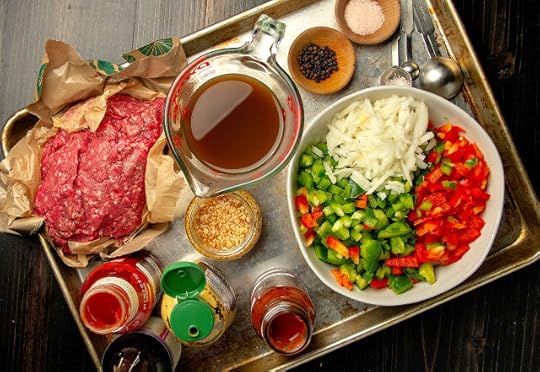
1 1/2 pounds extra lean ground beef
2/3 onion, diced
2 cloves garlic, minced
1 green pepper, finely diced
1 red pepper, finely diced
3/4 cup Primal Kitchen® Unsweetened Ketchup
1/4 cup Primal Kitchen BBQ Sauce
2 tablespoons of Primal Kitchen Avocado Oil
1 dash Worcestershire sauce
1 teaspoon Primal Kitchen Spicy Brown Organic Mustard
1 teaspoons salt, or to taste
1/4 teaspoon ground black pepper
1 cup chicken/bone broth or water
Instructions:

Saute peppers with 2 tablespoons of avocado oil until slightly softened. Add garlic and saute for 3 more minutes. Set aside.
Place ground beef and onion in a large skillet. Turn heat to medium and cook and stir the mixture constantly until the beef is browned and forms small crumbles, about 10 minutes.
Add cooked pepper mix to the meat skillet. Add 1 cup water and stir, scraping the pan to dissolve any brown flavor bits from the bottom of the skillet.
Mix in ketchup, Worcestershire sauce, BBQ sauce, mustard, salt, and black pepper. Return mixture to a simmer. Reduce heat to low and simmer, stirring occasionally, until the liquid has evaporated and the mixture is thick, about 40 minutes.
Nutritional Information (assuming 6 servings)
Calories: 256
Carbs: 8 grams
Fat: 10 grams
Protein: 33 grams
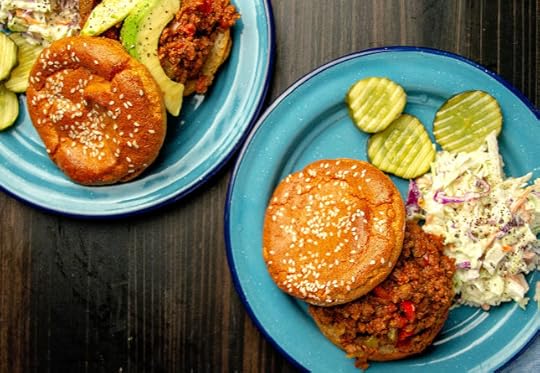

The post Primal Sloppy Joes appeared first on Mark's Daily Apple.



January 31, 2019
15 Easy One-Pot Keto Recipes
 Thanks to Paleohacks for today’s awesome keto recipe roundup!
Thanks to Paleohacks for today’s awesome keto recipe roundup!
Following the keto diet is a snap with these easy, one-pot recipes!
Skip the complicated recipes and keep dirty dishes to a minimum with these nourishing and delicious keto meals that are anything but boring. Think egg roll in a bowl with ground pork and plenty of deliciously stir-fried veggies, or whip up a quick pesto chicken for a simple Italian-inspired dinner. You can even update the classics with ultra-creamy tuna zoodle casserole.
Whatever you choose, there will be no slaving over a pot. We promise.
#1 Peace, Love and Low Carb | Pork Egg Roll in a Bowl
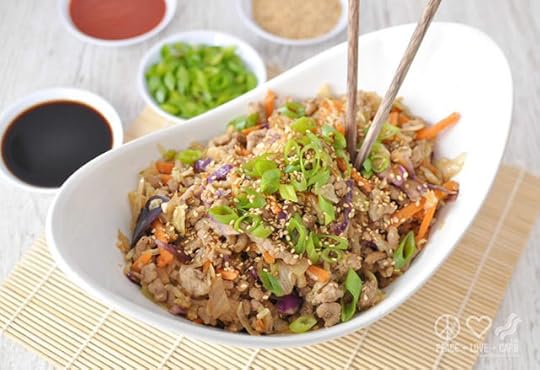
In need of a simple, one-pot stir-fry? This recipe will do the trick. Rife with veggies like onions and cabbage, this stir-fry gets its sweet and savory flavor from ginger, coconut aminos and rice vinegar. Add some spice with diet-compliant Sriracha or garlic-chili sauce.
#2 Paleo Scaleo | Chicken Bacon Ranch Casserole

Chicken, bacon and ranch are a winning combination, especially when prepared in a super-simple cauliflower rice-based casserole. Just be sure to use a diet-compliant ranch dressing!
#3 The Healthy Foodie | Creamy Cauliflower and Ground Beef Skillet
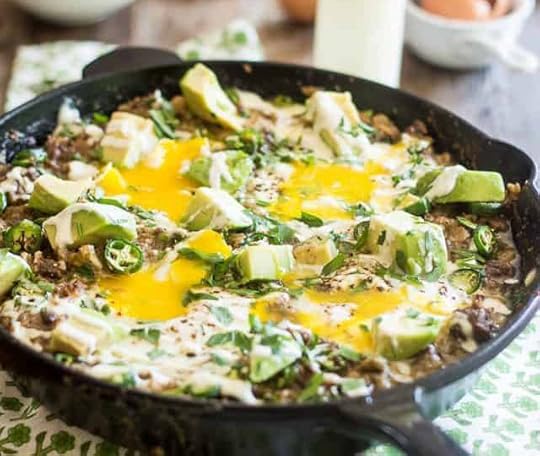
Ready for some soul food? Enjoy this hearty, creamy skillet packed with riced cauliflower, ground beef and eggs. The savory skillet works for any meal of the day, and gets its creamy texture from a blend of Paleo mayonnaise, sunflower seed butter, ghee and plenty of seasonings.
#4 That’s Low Carb?! | Low Carb Bacon Asparagus Breakfast Casserole
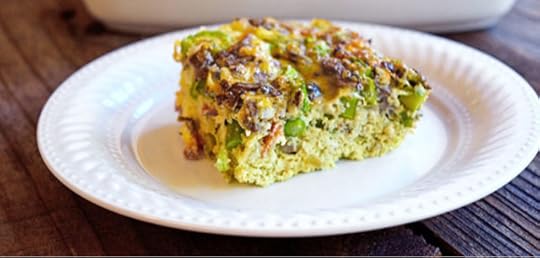
This eggy breakfast casserole is chock full of veggies like asparagus, celery and mushrooms. Simply mix everything together, pour into a casserole dish, and bake!
#5 The Nourished Caveman | Creamy Shrimp and Bacon Skillet
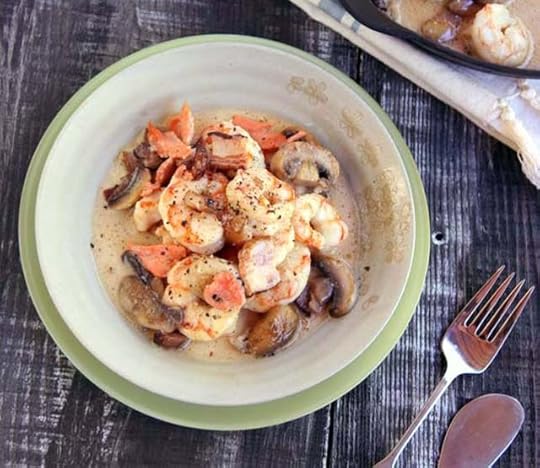
This bevy of seafood is made ultra-rich thanks to the addition of bacon, mushrooms and coconut cream. Feel free to serve this skillet as is or on a bed of zucchini noodles for a “shrimp scampi”-type dinner.
#6 PaleoHacks | Keto Turkey and Egg Breakfast Skillet
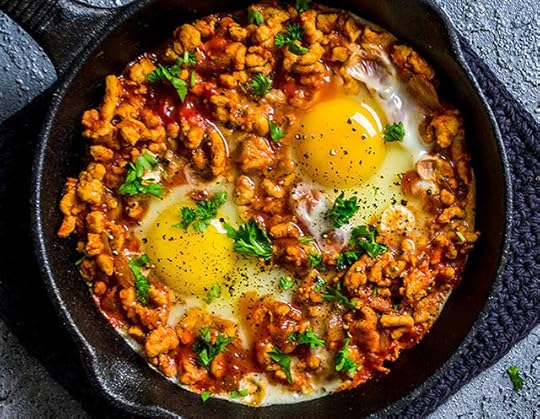
A hearty and sustaining breakfast is the best kind of breakfast, and this five-ingredient, super simple turkey and egg breakfast skillet fits the bill.
#7 Julia’s Album | One-Pan Pesto Chicken and Veggies
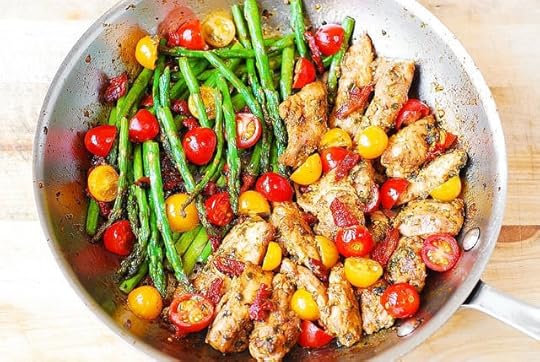
Everyone needs a go-to chicken and veggie recipe that’s completely foolproof. This simple and quick meal coats tender morsels of chicken and bright vegetables like tomatoes and asparagus with zippy pesto. It all comes together in 20 minutes, give or take.
#8 Paleo Plan | Paleo Shepherd’s Pie
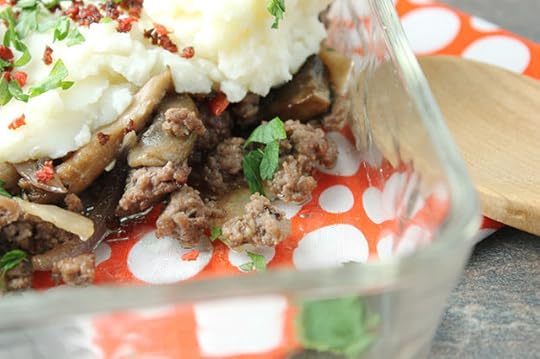
Irresistibly hearty and rich shepherd’s pie is usually made with mashed potatoes, but that’s definitely not keto-friendly. This recipe channels the same starchy deliciousness using mashed parsnips instead, dolloped over a well-seasoned layer of ground turkey and veggies. Yum!
#9 Cotter Crunch | Jalapeño Shrimp Veggie Bake
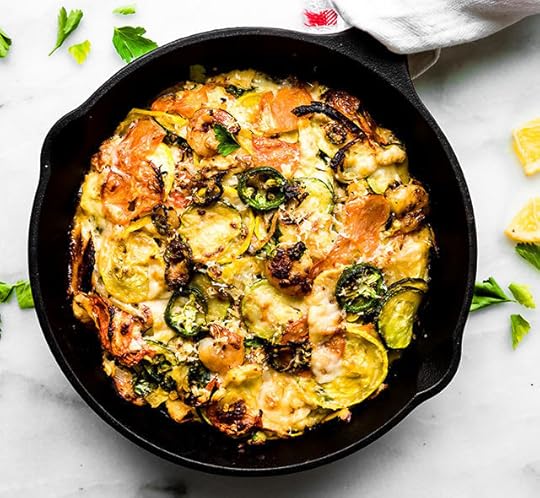
This spicy, creamy shrimp and veggie bake is a flavor explosion. Succulent shrimp joins tender veggies like tomato, squash, onion and jalapeño in a creamy sauce. The addition of a gluten-free, grain-free flour option keeps things crispy and crunchy after a trip to the oven.
#10 Grass Fed Girl | Low Carb Hamburger Casserole
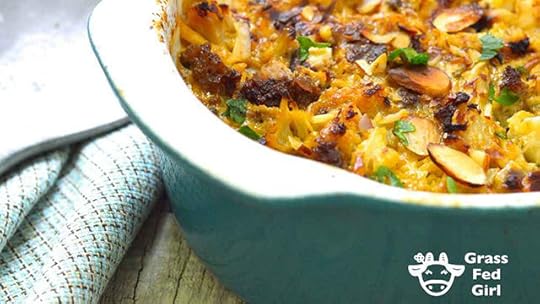
Ground beef and cauliflower are the base of this keto-friendly hamburger casserole. Spices like cumin, paprika and oregano add depth, while coconut milk (or cream) lends a silky mouthfeel. Finish with sliced almonds for crunch.
#11 PureWow | One-Pan Roasted Chicken with Carrots
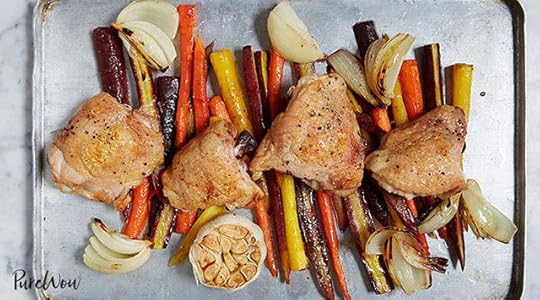
Cheap, colorful, healthy, filling and flavorful, this meal ticks all the right boxes. Oven-roasted chicken thighs rest atop a bed of roasted rainbow carrots and garlic and seasoned with fresh rosemary.
#12 Paleo Scaleo | Paleo Buffalo Chicken Casserole
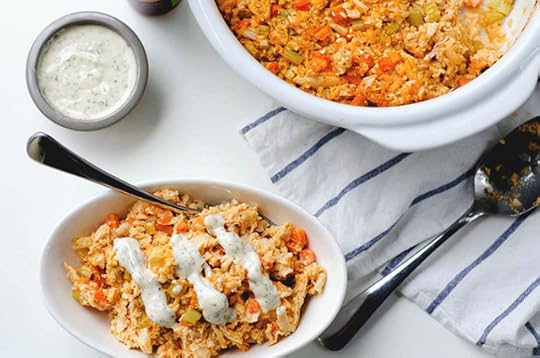
Get all the flavor of a Buffalo wing with none of the guilt in this one-pot, keto-friendly buffalo chicken casserole. Cauliflower, celery and carrots combine with shredded chicken, hot sauce and homemade mayonnaise for an ultra-rich but still good for you meal.
#13 PaleoHacks | Grain-Free Taco Casserole
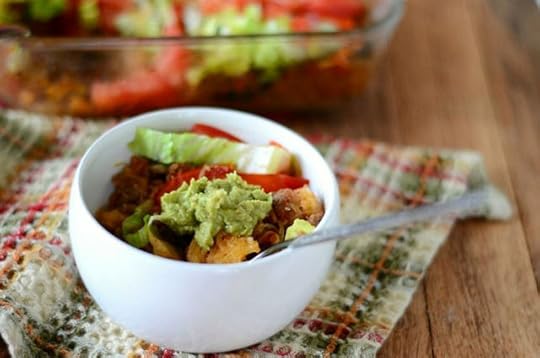
Give taco night a keto makeover with this grain-free casserole. Spaghetti squash gets topped with ground beef and fresh veggies like tomatoes, shredded lettuce, and guacamole for all the fresh Mexican flavors you crave!
#14 Keto Karma | Keto Slow Cooker Chili

Slow cooker meals are the ultimate in one-pot recipes. This super simple beef and sausage chili simmers with peppers, onions and tomatoes for a rich dinner that requires only 15 minutes of prep.
#15 Cotter Crunch | Tuna Green Chile Zoodle Casserole
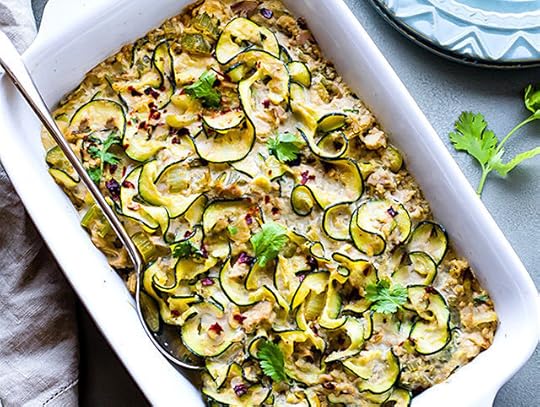
Do you love a good, classic tuna noodle casserole? Give it a keto makeover by nixing the grain-filled noodles for fresh, vibrant zucchini noodles. Pair it with sustainably caught, low-mercury canned tuna and you’re in for a real treat!
Thanks again to Paleohacks today. Do you have easy keto favorites to share—or questions about Primal/keto cooking? Share them below, and have a great week.

The post 15 Easy One-Pot Keto Recipes appeared first on Mark's Daily Apple.



January 30, 2019
Does Vegetarian Collagen Exist?
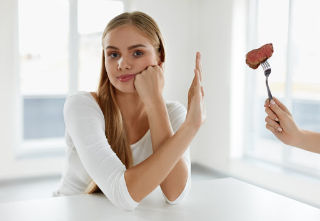 I’ll start with the bad news: There are no vegetarian collagen sources. Every collagen supplement you see on the shelf came from a living organism. Though somewhere down the line someone will probably grow legitimate collagen in a lab setting, it’s not available today or for the foreseeable future.
I’ll start with the bad news: There are no vegetarian collagen sources. Every collagen supplement you see on the shelf came from a living organism. Though somewhere down the line someone will probably grow legitimate collagen in a lab setting, it’s not available today or for the foreseeable future.
Now, some good news: Vegans and vegetarians probably need less dietary collagen than the average meat eater or Primal eater because a major reason omnivores need collagen is to balance out all the muscle meat we eat. When we metabolize methionine, an amino acid found abundantly in muscle meat, we burn through glycine, an amino acid found abundantly in collagen. If you’re not eating muscle meat, you don’t need as much glycine to balance out your diet, but it’s still a dietary necessity.
Collagen isn’t just about “balancing out meat intake.” It’s the best source of a conditionally essential amino acid known as glycine. We only make about 3 grams of glycine a day. That’s not nearly enough. The human body requires at least 10 grams per day for basic metabolic processes, so we’re looking at an average daily deficit of 7 grams that we need to make up for through diet. And in disease states that disrupt glycine synthesis, like rheumatoid arthritis, we need even more.
What About Marine Collagen?
Okay, but eating a product made from a cuddly cow or an intelligent pig is off limits for most vegetarians. What about marine collagen—collagen derived from fish bones, scales, and skin?
Back about twenty years ago, “vegetarians” often ate fish. A number of them still exist out in the wild, people who for one reason or another avoid eating land animals (including birds) but do regularly consume marine animals. If it jibes with your ethics, marine collagen is a legitimate source of collagen for vegetarians. The constituent amino acids are nearly identical to the amino acids of mammalian collagen with very similar proportions and properties.
It’s highly bioavailable, with the collagen peptides often showing up intact in the body and ready to work their magic—just like bovine or porcine collagen. In fact, if you ask many marine collagen purveyors, it’s even more bioavailable than mammalian collagen owing to its lower molecular weight.
I’m not sure that’s actually accurate, though.
According to some sources, marine collagen comes in smaller particles and is thus more bioavailable than mammalian collagen, but I haven’t seen solid evidence.
There’s this paper, which mentions increased bioavailability in a bullet point off-hand, almost as an assumption or common knowledge.
This analysis found low molecular weights in collagen derived from fish waste. Mammalian collagen generally has higher molecular weights, so that appears to be correct.
However, a very recent pro-marine collagen paper that makes a strong case for the use of marine collagen in wound repair, oral supplementation, and other medical applications does not mention increased bioavailability. It may be slightly more bioavailable—the lower the molecular weight, the more true that is—but I don’t think the effect is very meaningful. Mammalian collagen is plenty bioavailable (most efficacious studies use collagen from cows or pigs), even if it’s a few dozen kilodaltons heavier.
But even if marine collagen isn’t particularly superior to mammal collagen, it is equally beneficial.
For skin health: Fish collagen improves hydration, elasticity, and wrinkling in humans who eat it. And again.
For metabolism: Fish collagen improves glucose and lipid metabolism in type 2 diabetics. HDL and insulin sensitivity go up, triglycerides and LDL go down.
And although fish collagen hasn’t been studied in the treatment of joint pain, if it’s anything like other types of collagen, it will help there too.
What Are Strict Vegetarian Options?
What if you absolutely won’t eat collagen from marine sources? Is there anything you can do as a vegetarian to make up for it?
Make Your Own
You could cobble together your own facsimile of collagen by making an amino acid mixture. Glycine, proline, and arginine don’t cover all the amino acids present in collagen, but they’re widely available and hit the major ones.
Still, eating the amino acids that make up collagen separately doesn’t have the same effect on those collagenous tissues as eating them together in a collagenous matrix. One reason is that the collagen matrix can survive digestion more or less intact, giving it different biological properties and effects.
In one study, rats with osteoporosis ate collagen hydrolysate that scientists had marked with a radioactive signature to allow them to track its course through the body. It survived the digestive tract intact, made it into the blood, and accumulate in the kidneys. By day 14, the rats’ thigh bones had gotten stronger and denser with more organic matter and less water content.
Another study found similar results, this time for cartilage of the knee. Mice who ate radioactive collagen hydrolysate showed increased radioactivity in the knee joint.
In both cases, the collagen remained more or less intact. A blend of the isolated amino acids would not. The fact is that collagen is more than glycine. When you feed people collagen derived from pork skin, chicken feet, and cartilage, many different collagenous peptides appear in the blood. You don’t get any of those from isolated glycine.
That’s not to say it’s pointless. Pure glycine can be a helpful supplement, used in several studies to improve multiple markers of sleep quality. Just don’t expect it to have the same effect as full-blown collagen.
Get Adequate Vitamin C
Acute scurvy, caused by absolute vitamin C deficiency, triggers the dissolution of your connective tissue throughout the body. Teeth fall out, no longer held in by gums. Wounds don’t heal, your body unable to lay down new collagen.
Vegetarians usually don’t have any issues getting adequate vitamin C.
Get Adequate Copper
Copper is a necessary cofactor in the production of collagen. Studies show that you can control the production of collagen simply by providing or withholding copper.
The best vegetarian source of copper is probably dark chocolate, the darker and more bitter the better.
Get Adequate Lysine
Lysine is another amino acid that’s necessary for the production of collagen.
The best sources of lysine are in meat of all kinds, but vegetarian options include hard cheeses like parmesan and pecorino romano, as well as eggs.
True vegetarian collagen doesn’t exist. Strict vegetarians will balk. But if you can bend the rules a bit, realize that making marine collagen out of fins and scales and bones is far less wasteful than just throwing it away, and look at the benefits with an objective eye, you’ll be pleasantly surprised. Even if you don’t end up using marine collagen, at least you have a few tools for getting many of the benefits with quick shortcuts and optimizing your own production of collagen.
Have you ever tried marine collagen? If you’re a vegetarian, would you consider it?
Thanks for reading, everyone. Take care and be well.

The post Does Vegetarian Collagen Exist? appeared first on Mark's Daily Apple.



January 29, 2019
Dear Mark: Iron Followup
 Last week’s post on iron levels got a big response and garnered a ton of questions from you guys. Today, I’m going to clarify a few things and answer as many questions as I can. First, do iron and ferritin levels mean different things for men and women? If so, how do those differences manifest? What about premenopausal women vs postmenopausal women? Second, what do we make of the fact that ferritin is also increased in times of inflammation? Is there a way to distinguish between elevated ferritin caused by inflammation and elevated ferritin caused by high iron? Third, is desiccated liver a good option for liver haters? And finally, I share some exciting plague news.
Last week’s post on iron levels got a big response and garnered a ton of questions from you guys. Today, I’m going to clarify a few things and answer as many questions as I can. First, do iron and ferritin levels mean different things for men and women? If so, how do those differences manifest? What about premenopausal women vs postmenopausal women? Second, what do we make of the fact that ferritin is also increased in times of inflammation? Is there a way to distinguish between elevated ferritin caused by inflammation and elevated ferritin caused by high iron? Third, is desiccated liver a good option for liver haters? And finally, I share some exciting plague news.
Let’s go:
Emma wrote:
I’d love to see more info on iron levels as they relate to men and women differently. I recently had an iron infusion for low ferretin, not thinking much would change I actually experienced so many positive effects I didn’t even know were coming my way. I’m less cold, no more afternoon fatigue, less hair falling out, no more random palpitations, improved restless leg syndrome and the number one big change is it improved anxiety levels – in fact my anxiety is now gone. The last two are due to a connection between iron and dopamine. I learnt that children with mental health issues are often treated for low ferretin where possible, elevating levels to around 100 showing positive results (would love to see literature on this), for me my ferretin went from 20 to 130 and its changed my life, at 31 I haven’t felt this good in years. Yay iron!
That’s awesome to hear. Yes, it’s important to stress the very basic essentiality of iron. Without it, we truly cannot produce energy. And since energy is the currency for everything that happens in the body, an iron deficiency makes everything start to fall apart.
As for gender and iron, there’s a lot to discuss.
A good portion of women with hemochromatosis never actually express it phenotypically, meaning their lab tests don’t show evidence of dysregulated iron metabolism or storage. According to one study of hemochromatosis homozygotes (people who inherited the mutation from both of their parents), being a woman makes it 16x more likely that your hereditary hemochromatosis won’t actually present as iron overload.
Another study found that among mostly-age-matched men (42 years) and women (39 years) with hemochromatosis, 78% of the men had iron overload while just 36% of the women had it. Iron overload was defined as transferrin saturation over 52% combined with ferritin levels of 300 ng/mL for men and 200 ng/mL for women.
High iron levels are more of an issue for postmenopausal women than premenopausal women. The latter group regularly sheds blood through menstruation, and if anything, they’re at a higher risk of low iron. Plus, estrogen is a key regulator of iron metabolism. As menopause sets in and estrogen diminishes, that regulation suffers.
For instance:
In postmenopausal Korean women, high ferritin levels predict metabolic syndrome and subclinical atherosclerosis.
High ferritin predicts metabolic syndrome in postmenopausal but not premenopausal women.
In premenopausal Korean women, higher ferritin levels predict better bone mineral density; menopause nullifies this relationship.
Remember that ferritin is actually a measurable protein bound to iron, so testing a ferritin level is technically an indirect way to measure iron. Why is this important? Another characteristic of ferritin (the protein) is that it is an ACUTE PHASE REACTANT. This means that ferritin levels can fluctuate with illnesses and other inflammatory states in the body that drive up a ferritin value that is not related to an actual iron level fluctuation. Don’t get ferritin checked when you are sick with a cold or other illness.
This is a great point.
Ferritin is marker of long term iron storage, but it’s also an acute phase reactant that up regulates in response to inflammation or oxidative stress.
If you want to be really careful, you should get a HS-CRP test—that measures your overall inflammatory status. If CRP is elevated, ferritin can be elevated without saying anything about your iron status.
Come to think of it, if elevated ferritin can be a marker of inflammation and oxidative stress, the inflammation could be responsible for some of the negative health effects linked to high ferritin. Or, if having too much iron in the body can increase oxidative damage, it may be that high iron levels are increasing inflammation which in turn increases ferritin even further. Biology gets messy. Lots of feedback loops. However, the fact that many studies cited in the previous iron post that use blood donation to treat high ferritin have positive results indicates that for most people, ferritin can be, in most situations, an accurate estimation of your iron status.
To make sure it’s an iron problem, get a transferrin saturation test as well. That indicates the amount of iron you’re absorbing, with below 20% being low and over 45% being high. People with high ferritin and high transferrin saturation do have high iron levels. People whose ferritin is artificially enhanced by inflammation will have normal transferrin saturation levels.
I have one last question on this. You say “Don’t stop eating liver every week.” If you can’t stand the taste of liver, what do you think about taking liver capsules made from grass-fed New Zealand beef every day instead?
That’s a great option. Go for it.
People should generally aim for 4-8 ounces of fresh liver a week. Note the amount of desiccated liver in your capsules and multiply by 3 to get the fresh liver equivalent, then take enough each day (or all at once) to hit 4-8 ounces over the week. I hear good things about this one.
Mark,
Thank you for your article on HH. I carry the gene but have been managing my iron levels through phlebotomies. I am full Keto, meat and all and have found my iron levels have not been effected by going Keto. Early detection is the key and ongoing monitoring. Bring on the plague!!!
You joke about that now, but there’s a startup that’s breeding heritage rat fleas that produce a mild strain of the plague that evades the attention of the immune system and proliferates throughout the body to keep iron levels in check without killing you. I’m an early investor, have a couple swarms installed in my condo, and (knock on wood) so far have avoided anything worse than a sore throat and maybe a mild open sore or two. There’s actually a big rift forming between the techs who want to keep the fleas heritage and those who want to go ahead with CRISPR and engineer them. One variant has had a deer tick gene inserted that adds an anesthetic compound to the flea’s saliva. That way you can have a personal swarm on you and never feel any bites or itches.
I’m not sure about CRISPR just yet, but I gotta say it’s pretty nice to be covered in fleas and not feel the bites. Time will tell.
Ok, I’m joking.
That’s it for today, folks. I hope I’ve answered some of your concerns, and if not, let me know down below. Thanks for reading!
Want to make fat loss easier?
Try the Definitive Guide for Troubleshooting Weight Loss for free here.
References:
Lainé F, Jouannolle AM, Morcet J, et al. Phenotypic expression in detected C282Y homozygous women depends on body mass index. J Hepatol. 2005;43(6):1055-9.
Qian Y, Yin C, Chen Y, et al. Estrogen contributes to regulating iron metabolism through governing ferroportin signaling via an estrogen response element. Cell Signal. 2015;27(5):934-42.
Seo SK, Yun BH, Chon SJ, et al. Association of serum ferritin levels with metabolic syndrome and subclinical coronary atherosclerosis in postmenopausal Korean women. Clin Chim Acta. 2015;438:62-6.
Cho GJ, Shin JH, Yi KW, et al. Serum ferritin levels are associated with metabolic syndrome in postmenopausal women but not in premenopausal women. Menopause. 2011;18(10):1120-4.
Chon SJ, Choi YR, Roh YH, et al. Association between levels of serum ferritin and bone mineral density in Korean premenopausal and postmenopausal women: KNHANES 2008-2010. PLoS ONE. 2014;9(12):e114972.
The post Dear Mark: Iron Followup appeared first on Mark's Daily Apple.



January 28, 2019
13 Functional Exercises You Can Do At Work
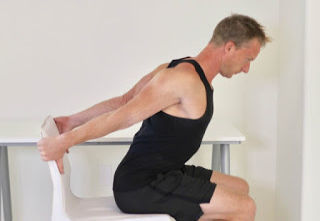 Good morning, folks. After a awesome week (and weekend) taking over the Whole30® Recipes Instagram (you can still check out all the great videos, tips and recipes I shared here), my team and I are taking a breather. Look for a success story later in the week. In the meantime, we have some practical ideas for your Monday morning. We’re shaking things up with a movement guide you can put into action at work today. Thanks to Jessica Gouthro of PaleoHacks for these awesome suggestions, and let us know which you’ll be adding to your routine.
Good morning, folks. After a awesome week (and weekend) taking over the Whole30® Recipes Instagram (you can still check out all the great videos, tips and recipes I shared here), my team and I are taking a breather. Look for a success story later in the week. In the meantime, we have some practical ideas for your Monday morning. We’re shaking things up with a movement guide you can put into action at work today. Thanks to Jessica Gouthro of PaleoHacks for these awesome suggestions, and let us know which you’ll be adding to your routine.
Working at your desk all day doesn’t have to mean poor posture and an achy body. Whether you sit or stand at work, remaining sedentary for hours takes its toll on the body. After just a few hours, your body will begin to stiffen, your lower back will ache, and you’ll grow sluggish.
But you can free yourself from common aches and pains associated with desk work in just a few minutes with these easy stretches to release the lower back and hips. You don’t have to do all 13 of these stretches at once. Instead, use this list as a guide and choose two or three stretches you think your body needs. Perhaps you’re looking for a nice stretch through your shoulders, or maybe you could really benefit from moves that help open up your hips. Every little bit of movement adds up when you’re sitting for long periods of time, and doing just one of these stretches every day will help you look and feel better, and avoid pain.
Try each of these 13 functional workspace stretches to relieve aches and pains and instantly improve your posture.
1) Standing Overhead Reach | 5 Breaths, 3x

Stand up from your chair with your feet about hip-width apart and toes pointed forward.
Clasp your fingers together and turn your palms facing up toward the ceiling.
Reach your clasped hands overhead, and press your palms upward while keeping your shoulders and core engaged.
Hold for five deep breaths and enjoy the stretch. Release. Repeat three times.
2) Butterfly Elbows | 4 Reps
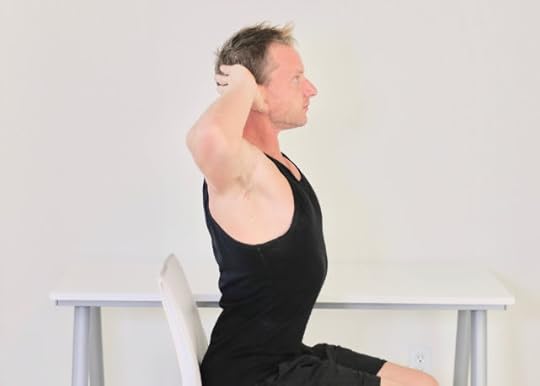
Sit tall in your chair and place your fingertips gently behind your ears. Do not interlock fingers or apply any pressure to your neck.
Lift your chest and ribs up as you stretch your elbows back to feel a lengthening across your chest. Breathe in deep to fill your lungs. On the exhale, round your back, drop your chin and bring your elbows to meet in front of you. Gently press your elbows forward to feel a stretch across your upper back and shoulder blades.
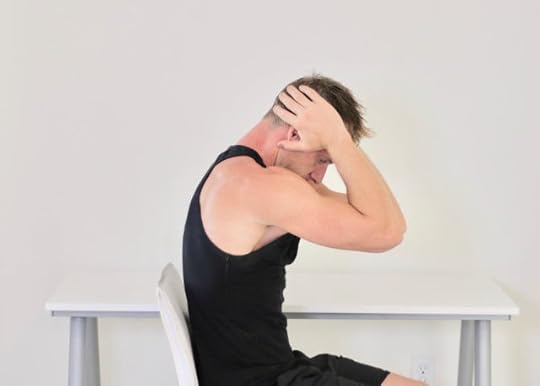
Inhale to return to the starting position. Continue alternating one movement per breath until you have completed four reps.
3) Chair Chest Opener | 5 Breaths, 2x
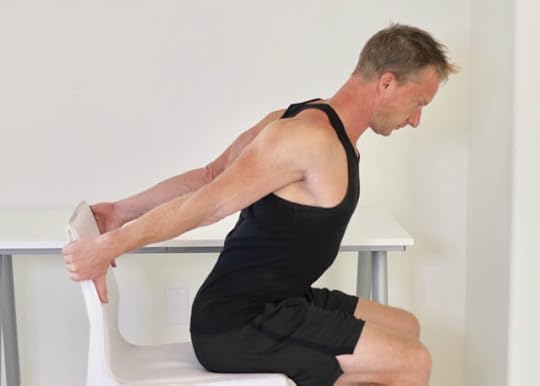
Scoot towards the front of your chair, and sit on the very edge. Reach your hands back with thumbs pointing down and grasp onto the sides of your chair.
Lift your chest and roll your shoulders back and down. Elongate your neck by imagining you can press into the ceiling with the top of your head.
Lean deeper into the stretch to feel the opening across your chest.
Take five deep breaths, then rest. Repeat a second time.
4) Standing Chair Lat Stretch | 5 Breaths, 2x
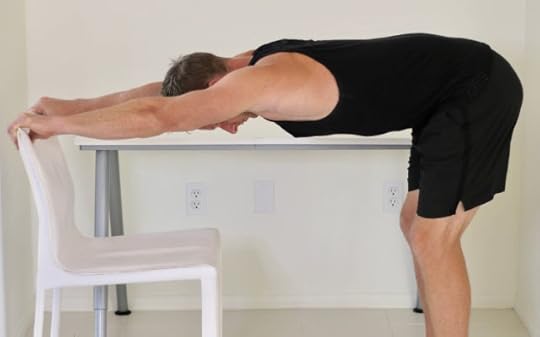
Stand facing your chair, about three feet away.
Keep a slight bend in your knees, then hinge at your hips and reach your arms long to grasp onto the back of the chair. Make sure your arms are straight.
Lengthen your shoulders and flatten your lower back, forming a straight line from hands to hips. Align your head in between your arms and take five deep breaths.
Release, then repeat a second set.
5) Standing Chair Lat Twist | 3 Reps Per Side
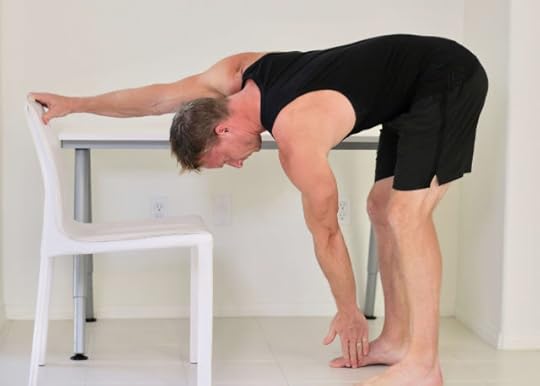
In the same position as the stretch above, reach your right hand down to your left foot to create a twist in your upper body.
Hold for two breaths, then return to the starting position with both hands on the chair and switch to twist in the other direction. Maintain a flat lower back and slightly bent knees the whole time.
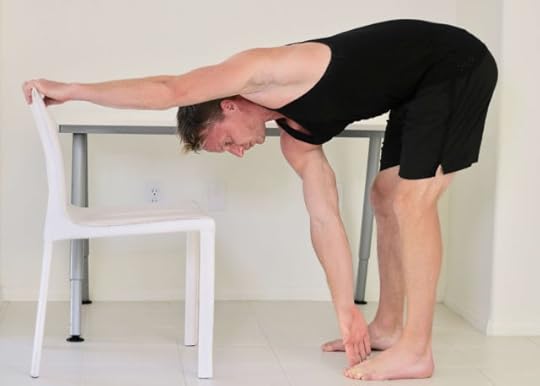
Repeat three times per side.
6) Mirrored Chair Pose | 3 Reps

Stand facing your chair with your feet together.
Hinge at the hips to squat down, aiming to mimic the height of the chair with the top of your thighs.
Keep your spine straight. Reach your arms up overhead with palms facing each other.
Hold for five full breaths, then release.
Repeat three times.
7) Seated Figure 4 Hip Stretch | 3 Breaths, 2x Per Side

Sit on your chair with both feet flat on the ground.
Lift your right leg and place your ankle across your left knee. Keep your right foot flexed.
Sit up nice and tall, then lean slightly forward as you gently press down on your right knee—just enough to feel a stretch in the hips.
Hold for three breaths, then release and switch sides.
Repeat two times per side.
8) Seated Spinal Twist | 2 Breaths, 3x Per Side
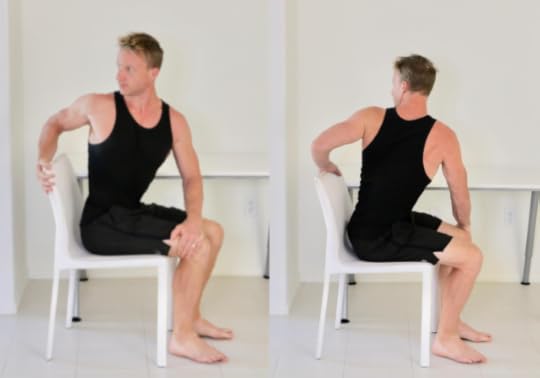
Sit on your chair with both feet flat on the ground.
Reach your left hand to your right knee and your right hand to the back edge of the chair.
Press gently with both hands as you look over your shoulder and rotate your torso. Lean slightly forward to allow more space for the twist.
Take two deep breaths, then switch to the other side.
Repeat three times per side.
9) Bound Neck Stretch | 2 Breaths, 3x Per Side

Sit up tall in your chair and reach your right arm straight down by your side.
Reach your left hand behind your back to clasp your right wrist, then tilt your neck to the right.
To increase the stretch, gently press your arm away from your torso.
Hold for two deep breaths, then release and switch to do the other side.
Repeat three times per side.
10) Alternating Fingers Wrist Stretch | 2 Breaths, 3x Per Side
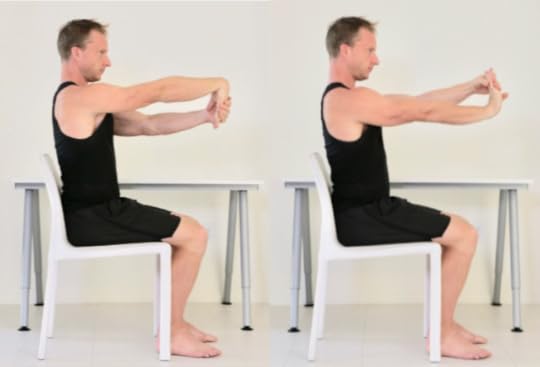
Sit up tall in your chair. Reach your right arm straight out in front of you with fingers pointing down towards the ground.
Use your left hand to gently pull on the back of your right hand to stretch the top of your wrist. Hold for two breaths.
Flip your right hand up so that your palm is facing out, and pull back with your left hand to stretch the bottom of your wrist. Hold for two breaths.
Alternate between stretching the top and bottom of your right wrist three times, then switch to the other side.
11) Hamstring Stretch | 3 Breaths, 2x Per Side
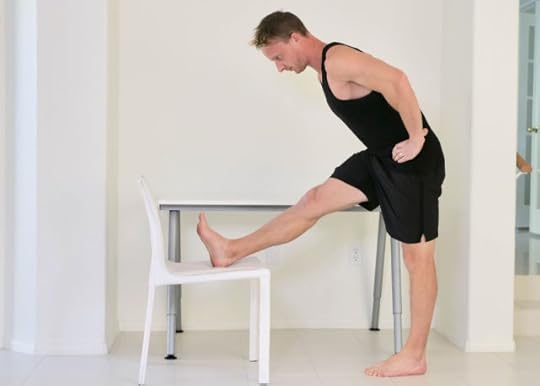
Stand up and face your chair. Step back about two feet.
Raise your right foot and place the heel on the middle of the chair with your foot flexed.
Place your hands on your hips and hinge forward, until you feel a stretch through your hamstring. Keep a slight bend in both knees to maintain muscular engagement.
Take three deep breaths, then switch to the left leg.
Repeat two times per side.
12) Chair Pigeon Pose | 3 Breaths, 2x Per Side
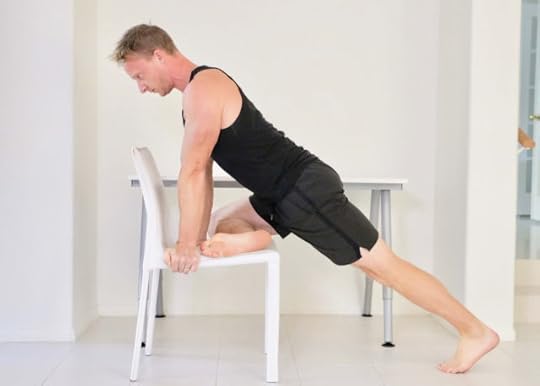
Stand facing your chair.
Place your right shin across the front of the chair, with your knee on the chair and foot off the edge. Keep your foot flexed.
Grasp onto the edges of the chair with both hands and step your other leg back to straighten out the knee and hip. You can control the depth of this hip stretch by bending or straightening your elbows.
Take three deep breaths, then switch to the other leg.
Repeat two times per side.
13) Single Leg Toe Pull | 2 Breaths, 3x Per Side
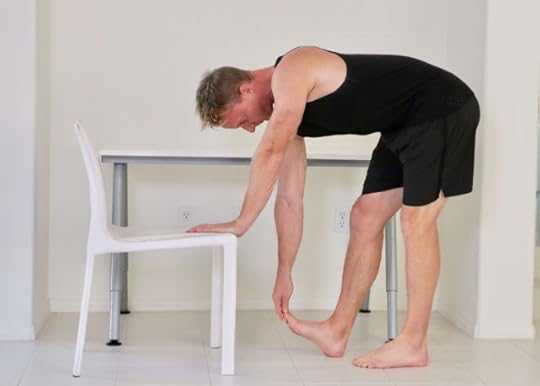
Stand facing your chair. Hinge forward at the hips and place your hands on the chair.
Grab your right toes with your right hand. Keep your left hand on the chair and a microbend in your left leg.
Pull slightly upward on your right toes until you feel a stretch in your calf and hamstring. Make sure to keep your hips square and your lower back as flat as possible.
Hold for two breaths, then switch sides.
Complete three sets per side.
Thanks again to Jessica Gouthro of Paleohacks. Questions or other ideas for staying relaxed and limber at work? Shoot me a line in the comments below. Have a great week, everyone.

The post 13 Functional Exercises You Can Do At Work appeared first on Mark's Daily Apple.



January 25, 2019
Weekly Link Love—Edition 13

Research of the Week
Gene drives—genetic engineering that the recipients pass along to all their offspring—now work in mammals.
Researchers fix Alzheimer’s in mice by targeting epigenetics.
Skipping dinner three times a work helps overweight women drop body fat.
During the age of great migration, Scandinavians with an individualist streak were more likely to move to the U.S. than Scandinavians with a collectivist streak.
Turns out that every single gene is probably important for every single cell.
Facial recognition is being used to fight illegal chimp trading.
New Primal Blueprint Podcasts

Episode 306: Logan Schwartz: Host Elle Russ chats with movement coach Logan Schwartz about strength, performance, movement, and mobility.
Each week, select Mark’s Daily Apple blog posts are prepared as Primal Blueprint Podcasts. Need to catch up on reading, but don’t have the time? Prefer to listen to articles while on the go? Check out the new blog post podcasts below, and subscribe to the Primal Blueprint Podcast here so you never miss an episode.
Media, Schmedia
Coming soon: GOOP ayahuasca ceremonies presided over by Gwyneth Paltrow.
Interesting Blog Posts
Asking patients to draw their illness.
Social Notes
Ten wellness leaders (including yours truly) gave their opinion on the best snack to curb cravings.
Paleo Magazine’s annual “Best of” contest is on, and it’s time to vote for your favorite [enter paleo-themed thing here]. There are some good selections in the Best Paleo Cookbook, New Product, Food Company, Lifestyle Company, Nut-Based Bar, and Paleo-Related Story sections.
Everything Else
Big data changed the way basketball is played in the NBA, and Carmelo Anthony is its most notable victim.
Seed sovereignty for small farmers and local varieties passes in the U.N.
Did a planet crashing into Earth seed us with the ingredients for life?
Horrible bullying from this elephant. Toxic.
Things I’m Up to and Interested In
I’d play this: Boardgame about the conflict between Viking settlers, Inuit settlers, and native Greenland Tunit peoples.
Article I found interesting: After getting a taste of freedom abroad, kids who move back to the U.S struggle with overparenting.
Something I always considered but never followed up with: Homeschooled kids tend to be better-educated and more tolerant, and homeschooling is on the rise.
Deal I’m happy to share: Trying to prep for the Big Game? Want something everyone will love, Primal or not? Just really, really love wings? Sign up for a membership at Butcher Box and get three pounds of organic chicken wings added free to every order for life. Get your orders in by 1/28 to ensure your wings arrive in time for the game.
I’m reminded of an oft-forgotten Primal Law: Avoid Stupid Mistakes.
Question I’m Asking
What do you think of homeschooling? Tried it, experienced it, for it, against it?
Recipe Corner
Not sure why meatloaf has a bad rep. Stuff is awesome.
I could do a potato diet if they looked like this.
Time Capsule
One year ago (Jan 20 – Jan 26)
The Role of Supplementation in Keto: What’s Uniquely Useful – What you might be missing.
Grok Didn’t Take Supplements, So Why Should I? – Why supplements make sense on a Primal eating plan.
Comment of the Week
“Hey Mark,
I assume your referencing the article regarding a supposed link between skipping breakfast and increased risk of diabetes due to how absurd it is?
Just checking, because otherwise my whole fasted morning routine from the last few years now seems that it could be my undoing.
Cheers!”
– I’d love to respond in full, Josh, but sadly I skipped breakfast and now I’m in an ambulance headed to emergency.

The post Weekly Link Love—Edition 13 appeared first on Mark's Daily Apple.



January 24, 2019
Warm Mushroom and Chard Salad with Bacon and Mustard Dressing
 Salads aren’t just for summer, and this recipe proves it. Warm, hearty, rich, with the deep flavors of mixed mushrooms, bacon (we have you at that, right?) and mustard dressing, this delicious side—or full-on meal—will make a believer out of you. Salads, done well, are for all seasons.
Salads aren’t just for summer, and this recipe proves it. Warm, hearty, rich, with the deep flavors of mixed mushrooms, bacon (we have you at that, right?) and mustard dressing, this delicious side—or full-on meal—will make a believer out of you. Salads, done well, are for all seasons.
But there’s more…. We’re loving the crunch of toasted pine nuts and the addition of poached eggs. It might just be the quintessential winter salad—and we’re guessing a new Primal favorite for your health-conscious table.
Servings: 4
Time In the Kitchen: 20 minutes
Ingredients:
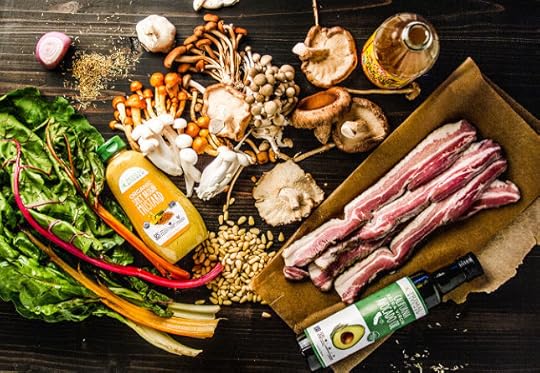
2 bunches rainbow or Swiss chard
2 cups sliced mushrooms (any variety; a mix is great, too)
6 strips crisp, cooked bacon, crumbled
½ cup toasted pine nuts
1/3 cup plus 2 teaspoons Primal Kitchen® Avocado Oil
2 tablespoons apple cider vinegar
1/3 cup Primal Kitchen Organic Spicy Brown Mustard
1 large shallot, minced
1 garlic clove, finely minced
1 teaspoon dried thyme
Salt and pepper to taste
Optional: Poached eggs
Instructions:
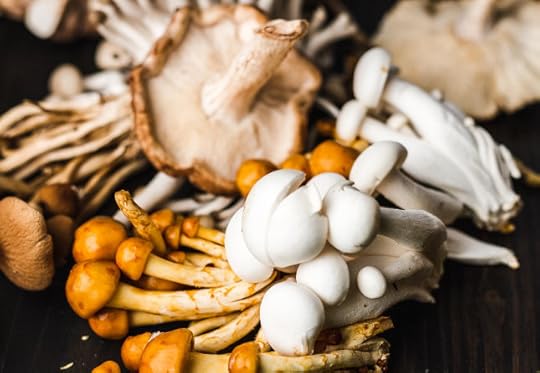
Wash, dry and chop rainbow/Swiss chard (Tip: Tear leaves off first and then chop stems.)
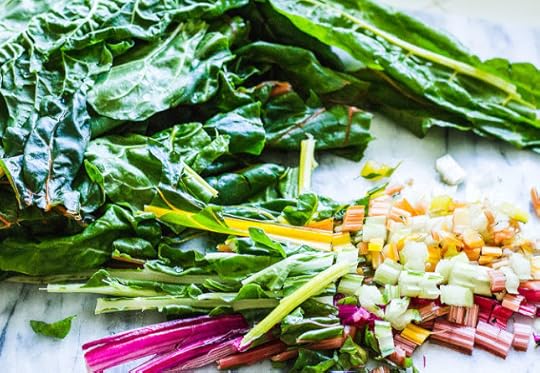
Heat 2 teaspoons avocado oil in a large skillet over medium heat. Add sliced mushrooms, sprinkle with salt and pepper, and saute until lightly browned, about 7 minutes.
Remove mushrooms from skillet and set aside.
Add chard to the pan and cook until wilted, about 3–4 minutes. Sprinkle with salt, stir, and add to a large mixing bowl.
Add remaining avocado oil, vinegar, mustard, shallot, garlic, thyme, salt and pepper to a mason jar. Shake well until emulsified, and add dressing to bowl with the chard.

Add mushrooms, bacon, and pine nuts to bowl. Toss well to mix.
Optional: Serve with chopped hard-boiled eggs or one poached egg per salad.

Nutritional Information (per serving, with one poached egg):
Calories: 474
Net Carbs: 9 grams
Fat: 39 grams
Protein: 18 grams

The post Warm Mushroom and Chard Salad with Bacon and Mustard Dressing appeared first on Mark's Daily Apple.



January 23, 2019
Is Iron the New Cholesterol?

One thing I’ve realized being in this game for so long is that if you’re convinced that meat truly is deadly, you’re not going to stop looking for reasons why. They’ve tried blaming just about every part of meat over the years, including the protein itself, the saturated fat, the cholesterol, the methionine, the char on BBQ, and even the obscure compounds like TMAO or Neu5gc. The latest component of meat they’ve zeroed in on is iron—the essential mineral responsible for energy production and a host of other vital functions.
The experts’ track record with all the other “evil meat components” has many of my readers skeptical, so they asked me to weigh in on iron.
Iron is an essential mineral, integral in the production of energy and the creation of blood cells. If pregnant women don’t get it, they can’t deliver oxygen and nutrients to their growing babies. If kids don’t get it, they shortchange their mental and physical development. If adults don’t get it, their basic day-to-day physiological function falls apart. Without adequate iron, our antioxidant defenses, our immunity, and our metabolic function all suffer. Hell, most countries even mandate the fortification of refined flour with large amounts of iron to prevent these tragedies.
Iron also has a dark side. A large body of observational evidence links elevated iron levels to diseases and disease states like type 2 diabetes, heart disease, insulin resistance, inflammation, Alzheimer’s disease, hypertension, fatty liver, hypothyroidism, arthritis, and cancer. You name it, it’s probably linked to elevated iron. And as much as I’d like to, I can’t dismiss these connections as non-causal.
For one, iron is inherently reactionary: The very same proclivity for electron exchange that makes iron so integral in biochemical reactions that address stress and support health means it can also create free radicals that damage DNA, cells, blood lipids, and increase stress and harm health.
Two, there’s a little something called hereditary hemochromatosis.
Hereditary hemochromatosis is a genetic condition increasing a person’s absorption and retention of dietary iron. This has benefits in certain contexts—carriers have a natural resistance to the bubonic plague, as one effect of hemochromatosis is to render white immune cells iron-deficient and thus resistant to the plague virus which feeds on iron—but it’s mostly negative in today’s relatively plague-free world. Most of the hemochromatosis literature focuses on homozygotes (carriers of two copies of the gene) and specific “iron overload-related diseases,” which include cirrhosis, liver fibrosis, liver cancer, elevated liver enzymes, “physician-diagnosed symptomatic hemochromatosis,” or finger arthritis. Those are bad conditions to have, to be sure, but that’s not even a complete list. Homozygous carriers of the mutation also have greater risks for diabetes, arthritis, fatigue, liver disease, and frailty and muscle loss. They’re more likely to experience neurodegenerative diseases like Parkinson’s and Alzheimer’s. Even heterozygous carriers (those who carry just one copy of the variant) have an elevated risk of iron overload compared to the general population.
Okay, okay. But couldn’t it be that the hemochromatosis gene is increasing disease risk through another, non-iron route? Perhaps high iron is just a marker of disease, not a cause. After all, most genes are pleiotropic—they have more than one effect.
Probably not. The most reliable treatment for hereditary hemochromatosis is phlebotomy. Literally removing iron from the body by draining blood is the first (and often only necessary) line of defense against hereditary iron overload. And it works really well.
Besides, phlebotomy may also be beneficial in people without clinical iron overload or hemochromatosis. It’s the most effective way to reduce iron stores and tends to increase insulin sensitivity. In insulin resistant men with fatty liver, blood donation normalized insulin sensitivity and liver enzymes. In meat eaters, blood donation reduced ferritin levels to match those of lacto-ovo-vegetarians and improved insulin sensitivity. One study even tested the effect of randomized phlebotomy on cancer incidence. After four and a half years, those subjects placed in the phlebotomy group lived longer, had less cancer, and had lower ferritin levels than the subjects who didn’t donate blood.
I can’t argue with the research, but the idea that a primary component of a food we’ve been eating for millions of years and to which we may even owe much of our brainpower—the iron in meat—still rankles. Is iron truly inherently “bad,” or is there anything about our modern environment that makes it so?
Possible Modern Influences On Iron Levels
Less Bleeding
One factor is that we don’t shed as much blood as before. Most men engage in far fewer bouts of direct violent conflict. Most people have fewer parasites feasting on their blood. And when’s the last time you exchanged blood oaths with anyone? We have fewer opportunities to bleed, in other words. That’s why regular phlebotomy can be such a useful tool for men (and some women) with too much iron in their bodies—it emulates all the bloodletting we used to do in a controlled, safe fashion.
Less Intense Activity
We use iron to generate energy. The more physical activity in which we engage, the more iron we utilize. This is usually couched in warnings for female athletes engaged in intense training, but it can also explain the beneficial effects of exercise in people with iron overload. There are even cases of “mild exercise” causing iron deficiency, so everything that increases energy expenditure—walking, gardening, hiking—will at least subtly reduce iron stores. More activity, less iron sitting around idle getting into trouble.
Too Many Seed Oils
I strongly suspect that the unprecedented dissemination of high-omega-6 seed oils throughout our food systems, our body fat, and our cellular membranes are exacerbating—if not causing—the relationship between excess iron and various diseases. Take the supposedly ironclad (pun intended) relationship between heme iron and colon cancer, which is mediated by iron’s peroxidative alteration of fatty acids in the colon. In animal studies that seek to show this relationship, you can’t get the colon cancer to “take” unless you feed the animal high-PUFA oils along with their heme iron. In one study, feeding heme iron to rats promoted colon cancer only when fed alongside high-PUFA safflower oil. Feeding MUFA-rich and far more oxidatively-stable olive oil alongside the heme prevented the colon carcinogenesis. In another paper, only mice consuming fish oil-based and safflower oil-based diets exhibited carcinogenic fecal peroxides after eating heme iron; a coconut oil-based group of mice had no negative reaction to heme.
Among a cohort of US nurses, where PUFA intake is around 7% of calories and comes from seed oil, iron intake has moderate links to colon cancer. Among a cohort of Swedish women, where PUFA intake is under 5% of calories with a greater proportion coming from fish, the association is far weaker.
What To Do About All This?
First, men and postmenopausal women should figure out their hemochromatosis status. Both men and women with hereditary hemochromatosis have elevated risks of iron overload-related diseases, but they are much higher for men. (Premenopausal women have a handy built-in mechanism for shedding excess iron—menstruation.) Modern men and older women, with our absence of intestinal parasites and our lower tendency to engage in bloody hand-to-hand fighting, have few opportunities to shed iron. Your doctor will be able to order the test, or you can go through a genetic testing service and look for positive hits on C282Y and H63D.
Do it earlier rather than later. Studies indicate that one of the biggest predictors of whether someone with genetic iron overload develops liver cancer is their age at diagnosis of hemochromatosis. Those who wait risk incurring more damage.
Even if you’re negative for hereditary hemochromatosis, you can still have iron overload. Determine this by asking your doctor for a ferritin test. According to the Mayo Clinic, for men, the ferritin reference range is 24 to 336 ng/ml, and for women, it is 11 to 307. That is a wide range, and levels that your doctor would probably classify as technically normal have been associated with insulin resistance, atherosclerosis, and reduced telomere length (a marker of aging).
From what I can tell, levels approaching 200 ng/ml in men should definitely be classified as “high.” And lower may be even better. In one study, egg-and-dairy-eating vegetarian men had ferritin levels of 35 ng/ml and better insulin sensitivity than meat-eating men with ferritin levels of 72 ng/ml. After donating enough blood to hit 35 ng/ml, the meat eaters insulin sensitivity improved.
Dr. F. S. Facchini has used blood donation to induce “near iron deficiency”—the lowest body iron store that allows normal red blood cell production—in his gout patients, clearing them of gout attacks for as long as they maintained it. His patients at high risk for heart disease also saw major benefits from hitting very low ferritin levels (“to levels commonly seen in premenopausal females”), including increased HDL and lower blood pressure, even if they started with normal ferritin.
What seems safe is to stay on the low end of normal—say, from 50-150 ng/ml—as long as no symptoms of low iron arise.
As for women? Higher levels don’t seem to correlate with the same health issues in women. Lucky.
Now, say you have high iron, whether it’s hereditary hemochromatosis or just high normal ferritin levels….
What Should You Do About High Iron Levels?
Donate Blood
The quickest, safest way that also does the most social good (if you care about that sort of thing) is to donate blood. When you donate blood, your body must upregulate hemoglobin production to replace the lost blood. That requires iron, which is taken from body stores.
Don’t Manage Iron Overload With Diet
By that I mean stuff like:
Don’t give up red meat.
Don’t stop eating liver every week.
Keep eating oysters.
Don’t religiously adhere to reverse-kosher (only eating meat in the presence of dairy to inhibit iron absorption).
If you make dietary iron the focal point, you’ll miss out on all the incredible nutrients iron-rich foods like red meat and liver can offer. Besides, you’ll run yourself ragged following even more food restrictive rules that increase the chance of other nutrient deficiencies.
Don’t Manage an Iron Overload That Doesn’t Exist
I’ve seen people go down the rabbit hole of iron obsession without actually confirming they even had too much iron. They started giving blood (even self-administered), trying to reduce iron absorption by pairing dairy and calcium with their iron-rich foods, avoiding iron-rich foods—totally blind. Iron is an important nutrient. Deficiency is real. Anemia is no joke. Get tested before you start messing around with iron.
Follow a Healthy Primal Eating Plan
Whether it’s keto, low-carb, moderate-carb, or even vegetarian, going Primal will mitigate many of the potential effects of high iron by:
Avoiding Seed Oils and Excess Omega-6 Fats. Seed oils almost certainly make the “iron overload problem” worse, and may even be responsible for its negative effects and link to various diseases.
Including Phytonutrient-rich Fruits, Vegetables, Herbs, Teas, and Coffee. Polyphenols both inhibit iron absorption and reduce the oxidative interaction between iron and lipids.
So to sum up, get tested and be aware of the iron issue, but don’t let it rule you. It’s iron overload, not overlord.
Take care, everyone. What do you think of iron? Ever get tested? Ever give blood? See any benefits?
Let me know down below!

References:
Tamosauskaite J, Atkins JL, Pilling LC, et al. Hereditary Hemochromatosis Associations with Frailty, Sarcopenia and Chronic Pain: Evidence from 200,975 Older UK Biobank Participants. J Gerontol A Biol Sci Med Sci. 2019;
Burke W, Imperatore G, Mcdonnell SM, Baron RC, Khoury MJ. Contribution of different HFE genotypes to iron overload disease: a pooled analysis. Genet Med. 2000;2(5):271-7.
Allen KJ, Gurrin LC, Constantine CC, et al. Iron-overload-related disease in HFE hereditary hemochromatosis. N Engl J Med. 2008;358(3):221-30.
Nowak A, Giger RS, Krayenbuehl PA. Higher age at diagnosis of hemochromatosis is the strongest predictor of the occurrence of hepatocellular carcinoma in the Swiss hemochromatosis cohort: A prospective longitudinal observational study. Medicine (Baltimore). 2018;97(42):e12886.
Larsson SC, Rafter J, Holmberg L, Bergkvist L, Wolk A. Red meat consumption and risk of cancers of the proximal colon, distal colon and rectum: the Swedish Mammography Cohort. Int J Cancer. 2005;113(5):829-34.
Liu B, Sun Y, Xu G, et al. Association between Body Iron Status and Leukocyte Telomere Length, a Biomarker of Biological Aging, in a Nationally Representative Sample of US Adults. J Acad Nutr Diet. 2018;
The post Is Iron the New Cholesterol? appeared first on Mark's Daily Apple.



Mark Sisson's Blog
- Mark Sisson's profile
- 199 followers



